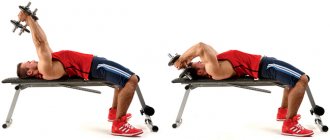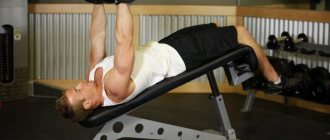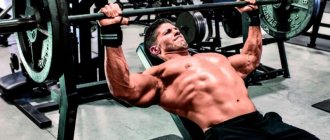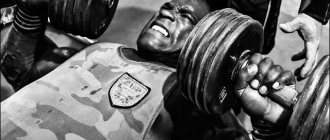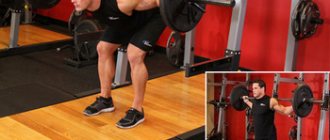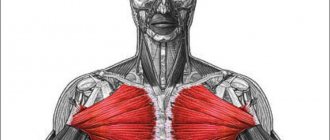Many people believe that you can increase your shoulder area by training only your biceps. However, most of the muscle volume is concentrated in the triceps muscle, the functions of which are to extend and flex the forearm. Thus, a training program for developing the upper body should include a triceps exercise such as a narrow-grip barbell press in various positions using special sports equipment. The bench press is a base (a mandatory part of the workout) for many parts of the body, and developing the shoulder girdle is no exception.
- Anatomical map of active muscles
- Benefits and Benefits of Exercise
- Variations of the exercise
- Close-grip barbell bench press
- Close-grip barbell press on a Smith machine
- Close grip EZ barbell press
- Close-grip incline barbell press
- Close-grip barbell press for girls
- Recommendations for performing the exercise
Anatomical map of active muscles
When performing a barbell press with a narrow position of the arms, the work includes: fascicles of the triceps muscle (medial, lateral, long), pectoral and deltoid muscles (acting as an assistant). In addition, stabilizers are activated, allowing you to maintain balance during movements: shoulder rotators, serratus muscles, wrist flexors. Thus, the triceps receive the greatest load in the process of raising and lowering the barbell. However, the wider the grip on the bar, the less the triceps work and the more the chest muscles work. This is why it is important to maintain a distance between your hands on the barbell when performing the press.
Muscle Atlas
Target, stabilizing, and accessory muscles activated during the close-grip barbell press
Target, stabilizing, and accessory muscles activated during the close-grip barbell press
Typical beginner mistakes
We have figured out the correct technique for performing a bench press with a narrow grip, but some athletes manage to make technical mistakes completely out of nowhere. Let's look at the most popular ones together.
Incorrect elbow position
In inexperienced athletes, the elbows tend to “spread” to the sides when lowering the barbell, which can lead to serious injuries to the elbow joints. To avoid this, try to mentally concentrate on the position of your hands, as if trying to press them to your ribs.
Open grip
Many athletes perform bench press exercises with a barbell with an open grip, citing the fact that this way they can better feel the contraction of the pectoral muscles. The statement is very controversial, I think, if there is a difference, it is mainly at the level of self-hypnosis. Be that as it may, when working with an open grip, even an experienced athlete risks dropping the barbell on his chest at any moment, and the outcome can be disastrous.
Warm-up
The exercise should begin with warm-up approaches. No matter how strong you are, any pressing exercise should begin with warm-up sets with minimal weights, for example, with an empty bar. This way, you will not only warm up all your joints and ligaments well before performing working approaches, but you will also mentally concentrate better on hard work, which will make the workout even more productive.
Grip width
Many short-sighted athletes take the phrase “close-grip bench press” too literally and place their hands almost close to each other. This should not be done; with such a narrow positioning of your hands, you will not be able to hold your elbows and torsos. The optimal width is slightly narrower than shoulder level, usually at approximately the level of the inner edge of the notches on the fingerboard.
Pelvic avulsion
The buttocks should be pressed firmly against the bench throughout the entire approach. By tearing them off, you create unwanted compression on the intervertebral discs of the lumbar spine and lose concentration on movement. The situation is similar with the back of the head - it also should not be torn away from the bench.
Proper distribution of load during training
Remember that heavy compound exercises, such as the close-grip bench press, require enormous energy expenditure and enormous recovery resources. Therefore, if your workout already contains, for example, a heavy classic bench press, you should not go out of your way to show maximum results in the close-grip bench press, this idea will not turn out to be anything good in the end. Practice this exercise with lighter weights and more repetitions for optimal results.
Forced reps
Don't get carried away with forced repetitions . Working in the negative phase with the help of a partner is an excellent aid for the bench press, but we would not recommend doing the same in the bench press with a close grip - it puts too much stress on the elbow joints.
Benefits and Benefits of Exercise
A number of advantages of bench press with a narrow grip include:
- Complexity of the exercise.
- Ease of movement and versatility.
- Increasing the volume of triceps.
- Increasing the mass of the triceps muscles.
- Development of physical strength.
- Engaging several muscle groups.
- Development of endurance.
- Using classic projectiles.
Thus, the benefits of barbell exercises for triceps are obvious. But it is important to note that the above benefits can only be achieved if the technique is performed correctly.
Homemade analogues of narrow grip bench press
The easiest way to repeat a close-grip bench press without a barbell is to do push-ups from the floor or from a horizontal pipe with your palms close to each other. In this way, you can work on your triceps outside the gym, but limiting yourself to your own body weight.
Another option is to take dumbbells, sit comfortably on an incline or horizontal bench (you can put stools in a row) and do a close-grip bench press with them. This is also a good option, however, it is quite difficult to control the movement.
And yet, it is optimal to perform the exercise with a barbell. Let's get back to it.
Variations of the exercise
When performing the same movements for a long time, muscles begin to get used to the load, as a result of which the quality of physical exercise decreases. To develop your triceps evenly and effectively, alternate barbell press variations, the number of approaches and repetitions, and increase the weight.
Close-grip barbell bench press
The classic version of close-grip barbell lifts begins with preparing the equipment. Decide on the weight of the discs. If this is your first time performing the exercise, you can use an unloaded bar. The initial goal of any exercise is to improve the technique of execution:
Close grip bench press
Technique for performing the classic version of the barbell press with a narrow arm position
Technique for performing the classic version of the barbell press with a narrow arm position: 2 stages of arm position
- Lie on the bench so that the support is on both feet. To do this, lower your legs to the floor and bend your knees at an angle of 90°.
- Raise your arms in front of you, grab the bar, place your hands shoulder-width apart (or slightly narrower).
- Bring the barbell out from behind your head.
- As you inhale, begin lowering the barbell until you touch your chest.
- The pause in the lower position should not exceed 1–2 seconds.
- Raise the barbell to the starting position.
Number of approaches and repetitions: 3-4 10-12 times depending on the level of physical fitness.
Video instructions for bench press with a narrow grip:
Close-grip barbell press on a Smith machine
This type of exercise involves using a Smith machine instead of a regular bench. The strength trainer consists of a metal base and racks connected by a beam. The design is equipped with threaded holes for the neck. The main purpose of using a Smith machine is to control exercise technique. The machine allows you to train intensively at the desired speed.
Smith machine
Smith machine design for weight training
Smith machine design for weight training
The technique of performing a barbell press with a narrow grip using the Smith design is practically no different from the classic version. However, there are a number of features that need to be taken into account:
Close-grip barbell press on a Smith machine
Performing a triceps barbell press in a Smith machine: stages of performing the exercise
Performing a triceps barbell press in a Smith machine: the starting and peak point of the exercise.
- Since the bar is fixed in the machine and can only move in one position, try to get into a comfortable, similar position. Initially, the bar should already be above the chest.
- Grab the bar with your hands, place your hands shoulder-width apart.
- As you inhale, lower the barbell, and as you exhale, lift it up.
Number of sets and reps for beginners: 3 x 10–12 reps; for professionals: 4 x 12–15 times.
Ideal technique:
Close grip EZ barbell press
To make it more comfortable to perform a barbell press with a narrow grip, you can use an EZ bar (curved). The apparatus allows you to quickly navigate the position of your hands during the exercise, as well as more accurately find the point of gravity of the barbell. The technique is similar to the classic bench press:
Close grip EZ barbell press
Technique for performing the exercise: using a curved barbell, correct placement of hands
Correct technique for performing the exercise using a curved barbell with a narrow arm position.
- Lie down on a bench, bend your knees and place them on the bench or lower them to the floor.
- Take the EZ bar and bring it to your chest.
- Slowly lower and raise the projectile.
Number of approaches and repetitions: 3×15 times.
EZ-bar press option:
Close-grip incline barbell press
Performing a barbell press with a narrow grip can be done on an inclined article at an upward or downward angle. The incline allows you to use different parts of the pectoral and triceps muscles. For full muscle development, it is recommended to perform inclinations from 15o to 60o. In addition, this version of the bench press helps to improve the technique of the classic bench press with a narrow arm position.
Close-grip bent-over barbell press
Bench tilt down: correct technique
Tilt of the bench at an angle downwards: correct technique of execution Technique of execution:
- Set the incline bench to the desired angle.
- Equip the bar with discs.
- Grasp the barbell with an overhand grip, placing your hands shoulder-width apart.
- Remove the barbell from the stand and bring it to your chest.
- Lower the bar slowly, without jerking, and raise it at an accelerated pace.
- Number of repetitions and repetitions: 3-4 10-12 times.
Precautions: Performing the exercise at an angle requires active work of the stabilizer muscles. Do not perform the exercise with heavy weights without a spotter.
Basic mistakes
Large incline at the bench
The lower the angle, the less stress on the target pectoral muscles. The optimal incline is 30 degrees from horizontal, which helps to load the triceps. It is not always possible to adjust the position of the bench. If options are limited, please note that the maximum angle allowed is 60 degrees. On a high slope, the shoulder joints experience more intense tension, and the emphasis shifts to the deltoid muscle.
Incorrect elbow position
They must be under the bar of the projectile. You cannot move your elbows towards your legs or head.
Using weights as in the horizontal press
The barbell press on an incline bench assumes that the working weights are always taken less than in the classic version. This is due to the fact that the exercise involves an isolated impact on the chest, when the assisting muscles are practically unused.
Lowering the barbell to the center of the chest
A strictly formed movement skill when performing a classic bench press usually leads to such an error. This option requires a change in direction to the collarbone area.
Close-grip barbell press for girls
Just like for men, the barbell press is useful in women's upper body training. Many girls believe that this type of exercise deprives their figure of femininity. But this is an absolute myth. The barbell (or barbell) press can not only transform the shoulder muscles, create relief and beautiful outlines of the arms, but also tighten the pectoral muscles.
There are no differences in exercise technique between men's and women's bench presses. However, we recommend that girls use lighter weights but higher reps.
Barbell press with a narrow grip in women's training
Barbell press with a narrow grip in women's training The correct technique for performing a barbell press with a narrow grip for girls and women
Correct technique for performing barbell presses with a narrow grip for girls and women
- Lie down on a bench with the barbell above your head.
- Stretch your arms forward, grab the bar with a straight grip, place your hands shoulder-width apart.
- Place your feet on a bench or floor.
- Bring the barbell to your chest and begin to lower it slowly, trying to keep your elbows in the same position.
- Raise the barbell as you exhale.
Number of approaches and repetitions: 3–4 12–15 times.
Recommendations for performing the exercise
To create a high-quality technique that will allow you to perform the bench press as efficiently as possible, follow these practical tips:
- The placement of hands with a narrow grip is usually an individual decision. However, the ideal option is 20–25 centimeters.
- In the starting position, do not straighten your arms completely; maintain a slight angle at the elbow joint.
- The principle of a high-quality bench press is “slow down and fast up.”
- Watch your elbows, they should be along the body.
- The barbell, when performing a bench press, should not deviate from its horizontal position.
- Don't forget about insurance.
- Alternate between variations of close-grip bench presses.
- Lift the barbell, contracting your triceps muscles.
- Eliminate rocking and inertial movements.
Training the triceps muscles is necessary to create defined, sculpted shoulders that are part of an athlete's athletic figure. Therefore, it is very important to observe the technique of performing the exercise and follow the practical recommendations outlined above. For men and women, the close-grip barbell press is equally beneficial. With its help, you can quickly achieve a proportional physique and give the shoulder girdle the desired shape. Don’t forget about regular training, gradually increase the weight of the equipment and the number of repetitions.
How to replace the exercise
Theoretically, the close-grip flat bench press can be replaced with any other basic movement:
- Press a dumbbell or kettlebell using a similar technique (replacing the apparatus).
- (hands are placed closer to each other).
However, such a “replacement” should be considered in the context of introducing variety into training and working the muscle from different angles. In terms of effectiveness for the shoulder girdle and triceps, the exercise is still one of the leaders, so its exclusion from the program is not recommended. The only actual cause may be injuries (for example, in the hand area), which do not allow technically correct execution of all elements of the movement.
This is a basic exercise that initially involves the use of heavy weights, since the load falls on a large number of muscles at the same time. It is impossible to target the triceps in this movement. For this, isolation exercises, such as others, are used.
Given the use of large weights and the effectiveness of working with weights in the range of 55-80% of 1RM, the number of repetitions per set should not be large.
- To develop strength, it is recommended to perform 4-6 repetitions.
- For the purpose of maximum hypertrophy - from 7 to 10.
Excellent results are demonstrated (a partner is needed to throw the pancakes), forced repetitions and failure approaches. These techniques help create maximum stress and the subsequent anabolic response.
An important aspect
is to draw up a program in such a way that the day of the arms does not overlap with the day of working on the chest. An excess of the same type of movements can negatively affect the growth of muscle mass throughout the shoulder girdle.
